Introduction
Growers throughout Florida have increased the use of protected culture to grow fruits and vegetables for the fresh market. Acreage of protected culture, including greenhouses, high tunnels (Figure 1), and shade houses, increased from 95 acres to nearly 386 acres from 2001 to 2014, with most of that increase occurring from 2009 to 2014.
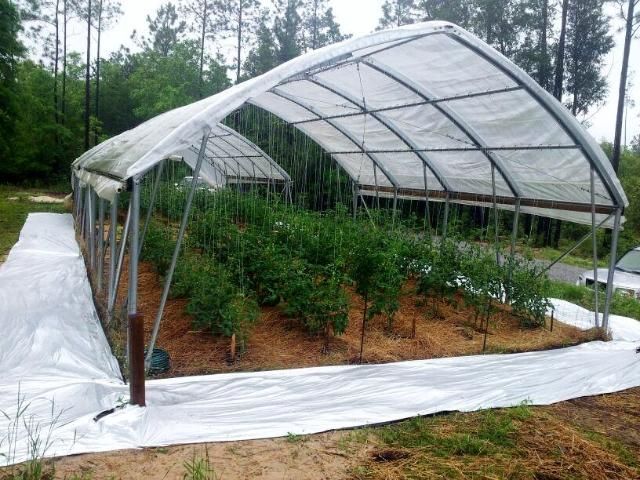
Credit: Blake Thaxton, UF/IFAS
Tomatoes represent one of the most popular vegetables grown in protected culture—approximately 50 acres, 23 acres of which are grown under high tunnels. Growers in southern Florida use high tunnels to continue production through the fall, winter, and spring seasons. In north Florida, though, the cooler temperatures make unheated high-tunnel structures unfeasible for growing through the winter. In north Florida, it is more common to use high tunnels as a season extension technique for tomatoes, with one crop in the spring and one crop in the fall.
Selecting the correct cultivar of tomato is critical and varies depending on the intended season, type of protected structure, training system, expected insect and disease pressure, postharvest handling techniques, and intended market. This publication will focus on the key factors affecting the cultivar selection decisions for competitive yields and marketability of tomatoes in north Florida. New cultivars are released every year and growers should evaluate new releases that may not be mentioned in this publication.
Types of Tomato Cultivars
Tomato cultivars today come in a wide variety of shapes, sizes, colors, breeding techniques, and growth habits. Typically, tomatoes are divided into aesthetic categories (including round or slicers, plum or Roma, cherry, and grape types [https://edis.ifas.ufl.edu/hs1189]), growth habits (determinate and indeterminate), and how they were bred (open-pollinated or hybrids). However, tomatoes of these different categories may be sold with the fruit of a cluster still on the stems and are known as on-the vine or cluster tomatoes. Cluster tomatoes are more commonly grown in greenhouses. Ripe tomato fruit may also be one of several colors or shades of colors, including red, pink, green, yellow, orange, purple, and even brown or black. Red is certainly the standard color, but many creative marketers are combining several colors together to create attractive packaging.
Tomato cultivars are typically classified into two growing habits: determinate or indeterminate. Determinate tomato plants are bushier, shorter plants that stop growing in height once the flowers appear on the terminal ends of their stems. The fruit of determinate cultivars matures over a shorter timeframe than those of indeterminate cultivars. Indeterminate tomato cultivars are taller plants that grow and produce fruit continually along the stems and do not stop producing vegetation once the blooms appear. Indeterminate tomato cultivars grow indefinitely taller and never set terminal flower clusters, only lateral clusters. Determinate cultivars will be small, bush plants and are easier to train with the standard Florida stake and weave system. Indeterminate cultivars will need a training system that may involve using high stakes (6–8 feet tall) with a Florida stake and weave system or using a trellis and overhead cable system.
Friendly disputes are common among growers and consumers over which tomato cultivars are best: hybrid, open-pollinated, or heirloom. Hybrid tomatoes have been bred and selected for specific traits, such as disease resistance, color, shelf life, yield, etc. Hybrids are the first-generation (F1) offspring resulting from a cross between two different but compatible parents. Hybrid tomatoes are the most frequently grown type of tomato throughout the world. Many cultivars released by the University of Florida have been very important in the commercial field industry in Florida. More recently, a few cultivar releases from the University of Florida have focused on higher levels of lycopene for improved flavor. This has made cultivars like Tasti-Lee® more popular with consumers in the grocery store and at local markets. Open-pollinated tomato cultivars breed true and result in each offspring being the same as the parent (F1= F2=F3). Heirloom tomatoes are a subtype of open-pollinated cultivars that have a long history and have been selected for desirable traits over time. Typically, heirloom cultivars have a history of 50 years or more. The popularity of heirloom tomatoes has greatly increased in the last ten years because of their reputation for having unique or excellent flavors. Heirlooms are generally sold for higher prices than other tomatoes. They are usually indeterminate cultivars and typically lack the thick vegetation required to protect the fruit from sun burn and other high-temperature-related fruit disorders.
Heirloom tomatoes are often very difficult to grow, especially in Florida, because they have little or no resistance to common diseases, are susceptible to cracking and cat-facing (Fig. 2), have a short post-harvest shelf life, and many do not set fruit under extremely high temperatures. For more information on growing heirloom tomatoes in Florida, see the publication Growing Heirloom Tomato Varieties in Southwest Florida (https://edis.ifas.ufl.edu/hs174). The use of protected culture has increased the success of growing heirloom tomatoes by helping to create a more favorable environment for tomato production and also a less favorable environment for diseases and physiological disorders. In addition, production under protected culture structures often helps facilitate a crop-training or trellising system needed for indeterminate cultivars.
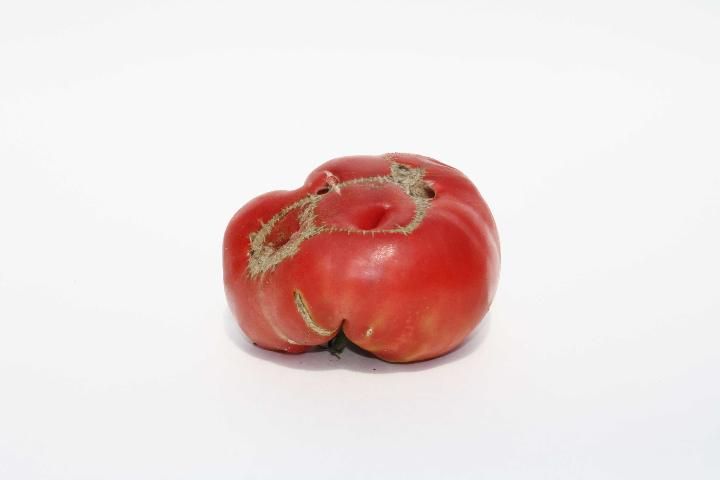
Credit: Blake Thaxton, UF/IFAS
Factors to Consider When Selecting Cultivars
There are several factors that should be considered before choosing tomato cultivars for different production methods. The variable factors have different levels of importance depending on whether the tomatoes are being grown in a protected culture situation or in a field-grown system. Factors that should be considered are:
- market acceptability
- production system and training Methods
- growing season
- disease resistance
- yields
Market Acceptability
As with all crops, it is important to produce crops that have a market and are in demand. When choosing cultivars, one of the most important factors is consumer demand. The majority of the Florida tomato industry produces cultivars for wholesale markets, and therefore chooses cultivars for their firmness and ability to withstand shipping and storage. The wholesale market cultivars are harvested green and treated with ethylene gas for ripening at a later date.
The local foods movement has allowed for smaller tomato growers to find new markets in which to sell their product. These markets generally serve directly to consumers at urban farmers' markets or upscale restaurants. Generally, these markets prefer unique tomato cultivars that are more difficult to source in a local grocery market where most tomatoes are ethylene treated tomatoes from wholesale distributors. Attributes desired in the direct-to-consumer urban farmers markets and upscale restaurants are (Fig. 3):
- superior flavor
- multiple colors
- unique shapes
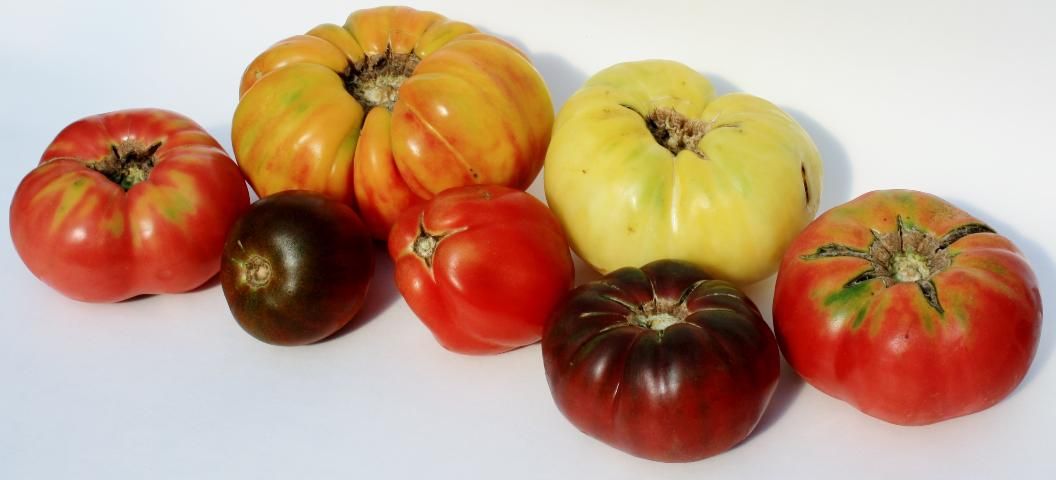
Figure 3. Heirloom cultivars exhibiting unusual shapes and colors that are becoming increasingly popular.
Credit: Blake Thaxton, UF/IFAS
For generations, small growers have found a market in rural farm stands and farm markets. Typically, both vine-ripened, uniquely flavored cultivars as well as traditional wholesale market cultivars can be sold at these markets.
When researching markets, communicate with the buyers to select the correct cultivars and give serious consideration to the demands of the desired market.
Production Systems and Training Method
Most of the tomato industry in Florida is represented by growers producing tomatoes in open-field culture using raised beds covered with plastic mulch and either seepage or drip irrigation. Most of this industry is growing determinate cultivars, training the crop using the Florida stake and weave (wooden stakes and string) method to keep the plants upright and manageable (Fig. 4). Grape tomatoes are managed in a similar fashion, but typically require a taller stake.
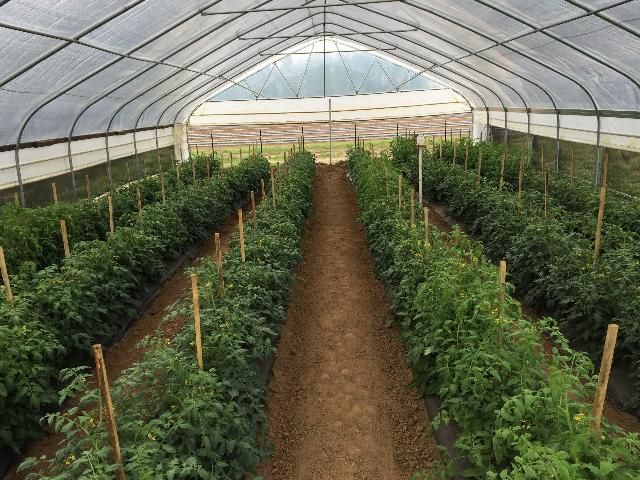
Credit: Blake Thaxton, UF/IFAS
Tomatoes are also grown in greenhouses, high tunnels, and even open shade-covered structures. Tomatoes are typically grown in the soil for open-field production, but soilless culture is used for producing tomatoes in greenhouse structures. Greenhouses have been used in Florida for tomato production for several years and the recommendations for Florida are found in the Production of Greenhouse Tomatoes—Florida Greenhouse Vegetable Production Handbook, Volume 3 (https://edis.ifas.ufl.edu/cv266). Most greenhouses have heating capability and are used to grow tomatoes beginning in the fall, carrying through the winter season, and into the spring. Indeterminate hybrid cultivars are the traditional type of cultivar grown in greenhouses; however, heirlooms are also grown in greenhouses now, too. Indeterminate cultivars grown in greenhouses may grow to be 20–30 feet in length from September to June. These indeterminate plants are managed using a trellis system including a top supporting cable and individual strings and clips to support each plant. Once the plant top reaches the cable and after the bottom leaves are removed, the plants are leaned and lowered. This process, known as leaning and lowering, is done several times (approximately every two weeks) during the season.
Tomatoes in high tunnels or open shade-covered structures may be grown using either the Florida stake and weave method or a trellis system, depending on the type of cultivar being grown and the length of season the tomatoes will be grown. Both training systems are being successfully used in Florida. If a determinate cultivar is grown and the producer is growing two crops per year (spring and fall), the Florida stake and weave system is very common. If indeterminate cultivars are grown over a long extended season, a trellis system may be preferred.
Growing Season Considerations (Insect Pests, Disease Resistance, Etc.)
Spring Season in North Florida
Tomato production in the northern region of Florida is perhaps most favorable during the normal spring season, March through June. This is due to a combination of factors, but mostly due to the lower insect and disease pressure and more moderate temperatures during the spring months. Silverleaf whitefly, a pest of tomatoes in north Florida, is not able to survive the winter in this region. Therefore, viruses vectored by this pest are much lower during the spring growing season. The silverleaf whitefly will be found in the crop by the middle or late part of the spring, but is usually not a major factor because of the late arrival. Thrips are the greater insect threat in the spring, including western flower thrips, which vector Tomato spotted wilt virus (Fig. 5). In certain areas of north Florida, including the Quincy area, Tomato spotted wilt virus can infect nearly 100% of susceptible cultivars in the open field. Consequently, selecting resistant cultivars or implementing pest exclusion methods in protected culture structures is critical, depending on your location. The amount of Tomato spotted wilt virus is much less in areas of north Florida, other than Quincy, but growers should determine the expected local level of virus pressure before planning their production strategies. Other insect pests will be expected in the spring including aphids, sting bugs, corn earworm, tomato hornworm, various armyworms, and other caterpillars. Spider mites will be a much more common pest in protected culture situations.

Credit: Mathews Paret
Diseases caused by fungi and bacteria should also be expected in the spring, even though they are more common during the fall season. Spring season diseases in the "wilt" group may include Fusarium wilt, bacterial wilt, southern blight, or sclerotinia. Preventative planning through crop rotation and other cultural practices should be implemented because these diseases are very difficult to control once established. Soil fumigation is usually not an option for small acreage growers. Recent advances using a resistant rootstock and grafting on a desirable cultivars scion show great promise for helping manage certain diseases like Fusarium wilt and bacterial wilt. Foliar diseases include bacterial leaf spot, target spot, gray leaf spot, early blight, and late blight. Preventative spray programs are commonly used in field production and will still likely be needed in protected culture situations. However, disease pressure in a well-managed and ventilated protected structure is generally much less than in the field. Inside protected culture structures, where ventilation is poor and plants have high levels of moisture on the leaves, growers should expect diseases such as gray mold (Botrytis), leaf mold, and even powdery mildew on susceptible cultivars. Growers should become familiar with the differences in the expected diseases associated with the different growing methods like high tunnel or greenhouse in comparison to the open field. For more information on tomato diseases in Florida, refer to the publication Disease Control for Florida Tomatoes (https://edis.ifas.ufl.edu/vh056).
Fall Season in North Florida
The fall season (July through December) in north Florida can be a very difficult time to grow tomatoes. The increased presence of diseases like bacterial leaf spot, target spot, and Tomato yellow leaf curl virus (Figure 6), vectored by the silverleaf whitefly, constitutes a greater threat to tomato crops during the fall season. Cultivars that are resistant to Tomato yellow leaf curl virus may be the only option for growing a successful crop in the fall. Tomato spotted wilt virus, however, is generally less of a problem in fall crops than in spring crops. The other major factor to consider in the fall is the extremely high temperatures during the period of tomato bloom and fruit set. Poor or even no fruit set is possible for certain cultivars due to the pollen becoming sterile when temperatures are too extreme. Cultivars vary in their susceptibility to this problem, and those that will set fruit at higher temperatures are typically referred to as "hot-set." Tomatoes transplanted in July or early August will likely need to be of a hot-set type. Heirloom tomatoes, as a group, are not able to set fruit in these extreme temperatures. In protected culture, fall plantings of tomato can be transplanted into this system in September to achieve a later crop to be harvested in November or early December. Hot-set cultivars are less necessary in later plantings.
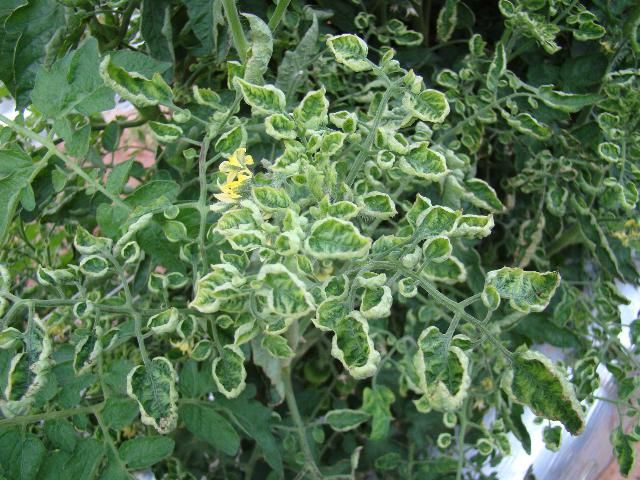
Credit: Mathews Paret
Protected Agriculture Structures
Tomato crops throughout the country, including Florida, are being grown using some type of covered structure to extend the season and improve quality to meet specific market demands. Protected culture can alleviate some of the problems of each season but can also bring other issues for growers to manage. When using a protected system growers should choose cultivars based on the system and season that tomatoes will be in production. Protected culture structures used in Florida include greenhouses, high tunnels, and even open shade houses. Greenhouses are permanent structures covered with one or two layers of polyethylene and are cooled with either passive ventilation or fan and pad evaporative cooling systems. In north Florida, greenhouses typically include a heating system, which is necessary to grow tomatoes nearly year-round, but in particular, through the winter. High tunnels are less expensive and are mainly a temporary, unheated structure with roll-up sidewalls and removable end walls for ventilation. High tunnels can be used to extend the tomato season by starting earlier in the spring, growing later in the fall, or both, but not typically through the winter. A third type of structure that can be used to extend the season through the hottest part of the year, a shade house, can be open or enclosed on the sides (Figure 7). Shade houses can be used from June through September for summer production. Research at the University of Florida in Live Oak determined that the shading level should be in the range of 40%. Tomatoes in all of these structures can be grown in either native soil or soilless hydroponic culture. For more information on greenhouse soilless culture of tomato, refer to Keys to Successful Tomato and Cucumber Production in Perlite Media (https://edis.ifas.ufl.edu/hs169) or go to the following web link (http://smallfarms.ifas.ufl.edu/crops/hydroponics/greenhouse_crops.html#tomatoes).
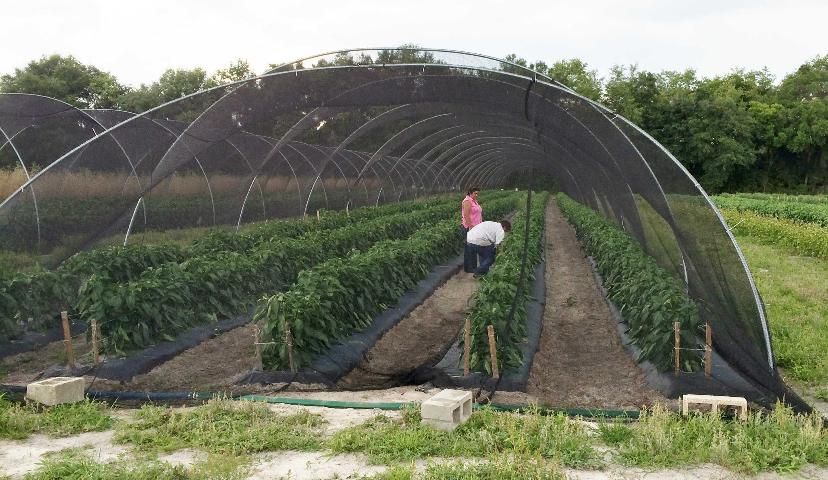
Credit: Blake Thaxton, UF/IFAS
For several years, the most commonly used cultivar in north Florida for hydroponic greenhouse production has been 'Trust'. Two other cultivars being grown in the southeastern United States, with some success, include 'Geronimo' and 'Big Dena'; however, there is limited experience with these in Florida. Heirloom cultivars are also being grown in Florida greenhouses, and the more popular ones include 'Brandywine', 'Cherokee Purple', and 'Arkansas Traveler'. Small heirloom cherry tomatoes, such as 'Brown Cherry', provide great flavor; 'Green Zebra' is used to provide a unique green exterior color. Many other heirloom cultivars may perform equally as well, but growers should evaluate them on a small basis before large scale production.
Tomato cultivar selection for production in a high tunnel is more variable because the seasonal growing intentions may be different from grower to grower. Spring-season cultivars that have been grown successfully include the same heirlooms as mentioned in the greenhouse section; the determinate cultivars, 'Tasti-Lee', 'Florida 47', and 'Amelia'; and the indeterminate cultivar, 'Panzer', which has done well in UF trials at Live Oak. Recent UF high tunnel trials in Jay, have evaluated performance of some of the top performing field-grown determinate cultivars in an organic system grown in high tunnels (Table 1). Fall tomatoes for trial in high tunnels or open shade houses include hot-set types such as 'Solar Fire,' 'Florida 91', and 'Phoenix'; and yellow leaf curl virus resistant cultivars, 'Charger', 'Tygress', and 'Security 28'. Potential cultivars have been identified for high tunnel tomato production for north Florida on a trial basis (Table 2).
Tomato cultivars recommended for open-field production are listed in the current versions of the Vegetable Production Handbook for Florida, Tomato Chapter (https://edis.ifas.ufl.edu/pdffiles/cv/cv13700.pdf). This reference lists the cultivars recommended for Florida and includes a summary of the attributes for each cultivar. Tomato cultivars are listed by the following types: large fruited or beefsteak, plum, cherry, and grape. Important characteristics, such as fruit size, disease resistance, "hot-set" capability, overall plant vigor, determinate versus indeterminate habit, etc., are all included. All cultivars listed have been successfully grown or show promise for production in Florida, based on research trials through the University of Florida.
Yields
As with most forms of agriculture, yields are important for north Florida tomato production in open-field and protected culture. Cultivars should be chosen that have a proven track record of providing quality and competitive yields in comparison with other cultivars available. The commercially available cultivars recommended, listed in the previous mentioned Vegetable Handbook for Florida, Tomato Chapter (https://edis.ifas.ufl.edu/pdffiles/cv/cv13700.pdf), by UF/IFAS researchers all have competitive yields. Yields work in combination with production systems and disease resistance. When recommended cultivars are chosen with correct horticultural qualities for the specific production system and disease resistant qualities, the yields of the chosen cultivar should be competitive.
For small farms, which are found all throughout north Florida, yields are often a less-important factor when choosing tomato cultivars. Other factors, such as market acceptability, can be more important because small farms hope to produce a product that is marketable and will command a premium selling price. This focus on market acceptability has contributed to the recent popularity of heirloom cultivars, which are often chosen particularly for markets that prefer superior flavors and unique shapes and colors over high-yielding hybrid cultivars. Although considering competitive, high-yielding cultivars is important when choosing cultivars, sometimes other factors, such as market acceptability, should also be considered.